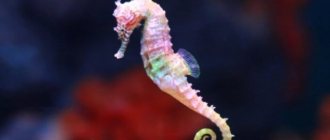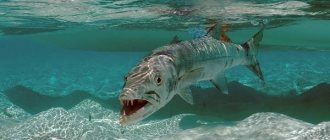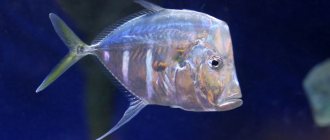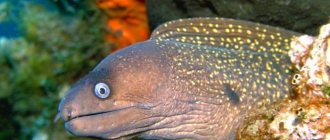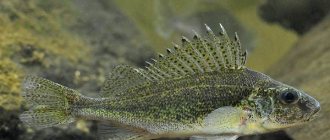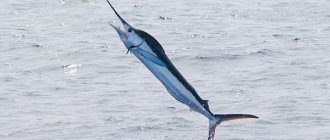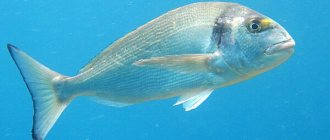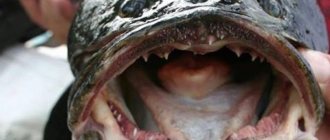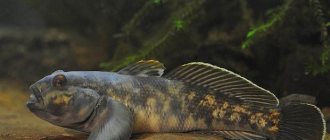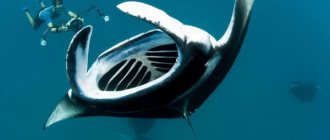- Wild animals
- >>
- Fish
Monkfish is a prominent representative of the inhabitants of the seabed. This interesting fish is difficult to study because most of its subspecies rarely come to the surface, and observation of them on the ocean floor is complicated by high pressure. However, anglerfish have even gained popularity as a gourmet fish.
Sea devils - description
| Class: | Ray-finned fish |
| Squad: | Anglerfishes |
| Family: | Anglerfish |
| Genus: | Anglerfish |
| View: | European anglerfish |
| Scientific name: | Lophius piscatorius |
Due to its deep-sea habitat, this species is poorly studied. It is also called the sea scorpion or fishing frog due to its special fishing rod on its head.
Photo: monkfish with prey in its mouth
Scientists suggest that the first monkfish appeared more than 100 million years ago. Their specific appearance is due to a long period of adaptation to deep-sea habitat conditions.
Some people believe that monkfish and anglerfish are two completely different fish. In fact, when they talk about monkfish, they mean a specific species - the European anglerfish. It is not so scary in appearance and is what is most often eaten. It is found at a depth of 200-250 m. But deeper-sea species are caught much less frequently. But both of them belong to the same group.
Appearance
When you first look at this creature, a remarkable organ immediately catches your eye - the “fishing rod”. The modified fin really resembles a fishing rod with a luminous float. This ugly monster, sometimes reaching up to two meters in length and 30-40 kilograms, can itself regulate the glow of its float. But there is nothing supernatural about this. In fact, the float is a kind of skin formation, in the folds of which amazing bacteria live. In the presence of oxygen, which they draw from the blood of the anglerfish, they glow. But if the monkfish just had lunch and lay down to take a nap, he does not need a glowing flashlight, and it blocks the access of blood to the fin-fishing rod, and the float goes out until the start of a new hunt.
The entire appearance of the monkfish reveals that it is an inhabitant of the depths of the sea. An elongated body, with an unnaturally large head, all covered with some kind of growths, vaguely reminiscent of either algae, or tree bark, or some kind of twigs and snags.
The body length of the monkfish is about 2 meters, and the animal weighs almost 20 kilograms. The body has a slightly flattened shape. In general, the anglerfish is not a very pleasant-looking fish. It is all covered with some kind of leathery growths that look similar to driftwood and algae. The head is disproportionately large, the monkfish's mouth and mouth are huge and unpleasant.
What does monkfish look like?
Females have the characteristic appearance of monkfish. Depending on the species, the appearance of the fish may differ, but the main characteristics are the same:
Photo: caught anglerfish
- bare skin that has growths but no scales;
- flattened body with a wide head;
- “fishing rod” - the front part of the dorsal fin with a flashlight at the end.
The species received its name from the Spanish conquistadors more than 500 years ago, when they first caught this fish. They were so amazed by her appearance that they were sure that they had caught the sea devil himself.
Photo: monkfish in water
The skin of an anglerfish has growths that are very similar in appearance to the bottom and algae. The skin can hang down like a fringe, merging with the bottom soil. The color of the monkfish is motley, similar to bottom sand.
- Fish grow up to 2 m in length and weigh up to 60 kg.
- The predator's mouth is lined with sharp teeth, sometimes in 2 rows, and the lower jaw is usually pushed forward.
- The eyes are small, see very poorly, and are located quite far from each other. At its usual habitat depth, vision is of little use to this fish. Constant darkness allows this fish to hide well, but also hides potential prey and males from it.
- It has another interesting adaptation - illium. That’s what her “fishing rod” is called. At the end of the illium there is an escu - a sac with luminescent bacteria. The fish can control its “lantern” and turn it on only when necessary. Light in such pitch darkness makes it easy to attract prey. And the huge mouth and razor-sharp teeth are capable of swallowing an opponent who is even larger than the devil himself.
The lifestyle and behavior of monkfish in nature
The depth at which these fish usually live is from 50 to 200 meters. Most often they are found at the very bottom, because there is nothing more pleasant for monkfish than just lying quietly on sand or silt. But it is only at first glance that the angler fish is idle. In fact, this is one of the ways of hunting. The animal freezes, waiting for its prey. And when it swims by, it grabs it and eats it.
The anglerfish also knows how to hunt in another way - with the help of its fins it jumps along the bottom and thus overtakes its prey.
Species of monkfish
The anglerfish family is quite diverse. But the most popular and widespread are 5 types of monkfish:
American monkfish
Reaches a length of 90 cm, weighs up to 22 kg. Among angler fishermen it is rightfully considered a long-liver. Life expectancy is up to 30 years. It is currently endangered due to overfishing. It lives in the waters of the northwestern Atlantic at depths of up to 670 m.
Black-bellied anglerfish
Smaller than the American one, it grows 50 cm in length, although sometimes specimens up to 1 m are found. Life expectancy is 20 years. Found in the eastern Atlantic, Mediterranean and Black Seas. The usual depth is from 300 to 650 m.
Western Atlantic anglerfish
Reaches 60 cm, lives in the western waters of the Atlantic Ocean, as its name suggests. The main share of the catch belongs to Brazil.
Far Eastern monkfish
Reaches a length of 150 cm. Lives in the Sea of Japan. This species is the deepest of those listed - it is found at depths of up to 2000 m. It is also a popular commercial fish.
European anglerfish (Lophius piscatorius)
A real record holder among his brothers. Body length up to 2 m, weight up to 57 kg. It lives in the Atlantic Ocean at a depth of up to 550 m. It is mined in England and France.
Origin of the species and description
Photo: Monkfish
Monkfish or anglerfish is a predatory fish from the order Anglerfish. The creature got its name from its unsightly appearance. This is a large order that includes 5 suborders, 18 families, 78 genera and approximately 358 species. The species are similar to each other morphologically and in lifestyle, so the number is imprecise and there is debate about individual representatives.
Video: Monkfish
Sea devils are classified as ceratiform fish. These fish are distinguished, first of all, by their lifestyle - they live at depths where most known marine inhabitants are unable to live due to enormous pressure. This depth can reach 5 thousand meters, which complicates the study of these fish.
Anglerfishes also share the following characteristics:
- camouflage color - black, dark brown without spots or other patterns;
- on the sides the fish are slightly flattened, although in general they have a teardrop shape;
- often the skin is covered with naturally formed plaques and growths;
- a characteristic process on the forehead is a “fishing rod” (only in females). With its help, angler fish catch fish, which mistake the appendage for prey and therefore swim up to the predator;
- females are always much larger than males;
- Anglerfish have a row of long teeth designed only for grabbing prey - in fact, the teeth are quite fragile, so sea devils cannot chew or bite.
Traditionally, the following common species of monkfish are distinguished:
- American anglerfish;
- black-bellied anglerfish;
- European anglerfish;
- Caspian and South African monkfish;
- Far Eastern monkfish and Japanese anglerfish.
Where does the anglerfish live?
The habitat of the monkfish is quite large. Representatives of this species can be found in the depths of the eastern Atlantic Ocean, the Black and Mediterranean seas. It is mined in the waters of the Sea of Japan, the North and Baltic Seas, as well as in the Okhotsk and Yellow Seas.
The sea anglerfish stays closer to the bottom, at a depth of 200-250 m and below. Larger individuals can go to depths of up to 2 km. During periods of prolonged hunger or immediately after spawning, many individuals rise higher, go into shallow water and even hunt birds.
general characteristics
There is another name for a fish with a flashlight on its head - it is an anglerfish . This is a predator that belongs to the order of anglerfish and the class of bony fish. Lives at the bottom of the sea. It reaches two meters in length. Average weight - 20 kg. Large individuals weighing 57 kg are also known.
The body is flattened, compressed in the abdominal direction. The mouth is several times larger than the head.
The anglerfish's jaw is inactive, the mouth is several times larger than the head
A distinctive feature of the monkfish is its slightly protruding lower jaw. She is inactive. The mouth is decorated with sharp teeth that are slightly curved inward. The jaws have flexible and thin bones that allow the anglerfish to swallow large fish. There are small eyes at the top of the head.
A separate process grows from the dorsal fin. It is shifted to the upper jaw and represents a fishing rod. There is a leathery formation on it - it serves as bait and is a bag of mucus in which luminous bacteria live. The angler can turn off the light for a while so as not to attract the attention of large predators.
The habitat of deep sea flashlight fish is varied. It can be found in countries such as:
- Canada;
- USA;
- Japan;
- Korea.
Some representatives of the species are found in the waters of the Black and Yellow Seas. It can live at different depths.
Angler fish can live at different depths
What does an anglerfish eat?
All anglerfish are predators. They eat all living creatures that come their way: fish, deep-sea squid, shrimp, even waterfowl. Their stomach is dimensionless, and their hunger is almost insatiable.
Sea devils are very voracious. Their stomach allows them to swallow prey that can exceed the size of the fish itself. Fishermen say that if a monkfish gets into the net along with another catch, then it is able to eat all the rest of the fish.
But the structure of the jaw is such that the monkfish cannot spit out its prey. The sharp teeth are curved towards the mouth, and in some species such teeth grow not only above and below, but also in two rows. When the mouth opens, low pressure is created, creating a vacuum that literally sucks the victim in. Therefore, without calculating the strength and without comparing the sizes, the monkfish often dies by choking on an overly large meal or bird feathers.
Why does an angler need a flashlight?
In the depths of the ocean there is a fierce struggle for survival. Environmental conditions cannot be called favorable for life: cold, darkness, enormous water pressure, oxygen deficiency. The edible inhabitants of the abyss are few in number and try to hide well from their predatory pursuers.
To find prey for lunch, a predator needs to interest it in something. For these purposes, the monkfish uses a luminous “light bulb” at the end of the elongated dorsal fin. The long rod-shaped outgrowth is called illicium. The role of a lantern is played by a leathery sac filled with mucus. Luminescent bacteria live and multiply inside the tank. The fish can manipulate the flame, expanding and contracting blood vessels at will. When the blood vessels are compressed, the bacteria are deprived of oxygen entering the skin gland through the bloodstream, and the light goes out. Vasodilation allows you to “turn on the light bulb.” As a result, the glow looks like Morse code signals - a series of long and short flashes.
To lure prey, the anglerfish must lie down on the ocean floor and hide, blending into the background of silt and algae. The predator then turns on and off the light at the end of the rod. This blinking looks like glare on the scales of swimming small fish. Curious fish swim closer to the light and find a terrible death in the teeth of the deep monster. The capture process is very fast, counting in milliseconds.
The difference between external and internal pressure gives the hunter an additional advantage. Thanks to this feature, a powerful stream of water arises, which drags the prey directly into the mouth of the predator. If necessary, to overtake prey, which, out of caution, is kept at a safe distance, the hunter can jump far forward from his shelter. To jump, the predator uses the reactive force of jets of water, which it passes through its gills.
The monster does not suffer from lack of appetite. The monkfish is able to include in its diet prey that is three times its length. The anglerfish's stomach stretches to the desired size, but it is still not rubber. It happens that a hunter chokes to death on his own prey because it is too large, and the teeth curved inward do not allow him to spit out the prey back. The anglerfish feeds variedly. In the stomachs of various representatives of this type of fish, mackerel, cod, flounder, small stingrays and small sharks were found.
The anglerfish rises to the surface of the water during the spawning period, when it intensively gains weight. There are witnesses to cases where an anglerfish jumped out of the water to swallow a large seabird, which it could not digest and subsequently died.
In different species of anglerfish, the attachment location of the process with the luminous sac may differ. Ceratias holboelli controls its long fin, retracting it inside the body at will so as not to slow down its movement. Galatheathauma axeli holds illicium in its mouth.
Natural enemies
Monkfish have almost no natural enemies. Their appearance allows them to carefully camouflage themselves at any bottom, and their gluttony and cunning hunting allow them to defeat opponents that are larger than them. In addition, at the depths in which the angler fish prefers to live, there are quite few inhabitants. The anglerfish rarely encounters large sea predators, but it can defeat all small ones without much damage, since it is at the top of the food chain.
The anglerfish is not of particular nutritional value for marine life, since the bulk of its body mass is in its head and huge mouth. Not a single inhabitant of the depths purposefully hunts him.
Anglerfish with an open mouth
The enemies of the anglerfish are considered to be giant squids, large octopuses and dragon fish, isopods, goblin sharks and “hell vampire” mollusks. Quite large anglerfish were found in the stomachs of these marine inhabitants.
The main damage to the population comes from the consumption of tadpoles and eggs by whales, sharks and other marine fish. Anglerfish do not protect their young, and therefore they drift into the waters, left to the whims of fate.
The main enemy of monkfish can be considered the person who catches it on an industrial scale. More than 30 thousand tons of this marine life are caught annually. In countries such as Brazil or France, the catch is put on stream, and the products are also exported to other countries.
Commercial importance of monkfish
Despite its name and peculiar appearance, monkfish is an edible bottom-dwelling fish that is of quite great commercial importance. Environmentalists are even trying to ban its fishing on the European coast, since here angler fish are caught not with fishing rods, but with the help of nets and trawls. The meat of representatives of the genus Lophius has excellent taste and is similar to lobster meat. It has almost no bones, it is white in color, dense in consistency, but at the same time tender. French and Spanish gourmets consider it a delicacy.
The predator's head is used to prepare delicious rich broths and seafood soups. Boiled monkfish meat is added to various salads, cut into pieces or cubes, it can be grilled or stewed with vegetables. Steamed or baked in parchment, anglerfish meat is ideal for dietary nutrition, since its fat content is minimal, and there are no carbohydrates at all in the presence of a large amount of proteins, various minerals, amino acids, as well as vitamins B, E, PP, A and D. In addition, the calorie content of monkfish is only 68.2 kcal.
Features of character and lifestyle
Sea devils are significantly different from other representatives of the animal world. This is manifested not only in appearance and method of hunting. Thus, sexual parasitism is common among anglerfish, and males are so different from females that some time ago they were classified as different species. There was even a theory that anglerfish are hermaphrodites. But in reality everything is much more complicated.
Reproduction and offspring
The reproduction process of monkfish can amaze no less than their appearance. Males search for a female by smell. Their sizes are simply incomparable in relation to each other, and therefore they reproduce in a very non-standard way.
- The male chooses a female for himself, then attaches himself to her and gradually loses himself, becoming literally one with her - he begins to feed at her expense, gradually loses his organs, becoming just a shoot with a single fertilizing function.
- For a successful suction process, it is important for the male to choose the right position to approach the female. Potential brides have very poor vision, and therefore may inadvertently eat the future groom.
Different species of anglerfish are ready to spawn at different ages. For some, this occurs almost immediately after transformation from a tadpole, while for others, for example, the European anglerfish, the appropriate age occurs only at the age of 14.
Female anglerfish and male
For spawning, which occurs in the spring, anglerfish often go to greater depths than usual. During one spawning, the female is capable of producing up to 3 million eggs. The caviar is spawned in the form of a long and wide ribbon. The size of the eggs can reach 4 mm. Females do not keep track of the eggs. They mark her and swim away. After a few days, the eggs turn into tadpoles, which feed on plankton. After 4 months, defenseless fry are able to settle to depth on their own.
Certain species of deep-sea anglerfish spawn in certain secluded places. Males fertilize the eggs at the spawning site. In the same way, fish do not monitor their offspring and do not protect them.
Male parasitism
Anglerfish are known for their sexual parasitism. And this process has hardly been studied by modern scientists. They know for sure that the male parasitizes the female, becoming her appendage. And there can be up to six such parasites on one fish at a time. Moreover, if the male has not found a female, he dies very quickly.
Female anglerfish and several males
Males have more developed vision and hearing, but nevertheless they are not able to survive without a female. Males bite into the female’s body, feed on her nutrients, gradually acquiring blood vessels.
There is a theory that the monkfish fish has some kind of alternative version of immunity, which gives it the opportunity not to reject the attached parasite, but to accept it and allow it to germinate.
Features not related to reproduction
A deep fish with a fishing rod on its head has many other differences from the usual inhabitants of the water.
- For example, she does not have a swim bladder. It allows other representatives of aquatic flora not to drown under their own weight. But the angler fish lives at sufficient depths that it simply does not need such an organ.
- Another feature that is of great interest to scientists is where the luminescent bacteria that live in its “fishing rod” come from in fish. There are two theories. According to the first, the eggs are received by bacteria from the mother. The second theory is that females simply encounter these bacteria while they swim.
- The glow occurs with different intensities. There may be flashes, increased or decreased glow. Scientists have not yet been able to study this point either. It is believed that this may be related to blood supply and the amount of oxygen.
Reproduction and breeding
The ability to reproduce in monkfish is different. The European anglerfish is ready for fertilization at the age of 6, and the female when she turns 14. It is interesting that northern fish spawn in the spring, and the inhabitants of the southern seas - from winter to summer. To lay eggs, the female goes down, and the male immediately begins to fertilize it. The size of the eggs varies from 2 to 4.5 mm.
It is difficult to breed anglerfish in a home aquarium, because there are problems with introducing partners.
Sex differences
The body of females is larger than that of males. Their length is 1-1.5 m. The male's body is only 3 cm and is similar to a tadpole. The female has a wide mouth and a stretchable stomach, so she is able to eat someone even larger in size. Females lure fish with the help of a luminous fishing rod, which males cannot boast of. But they have developed vision and sense of smell to find a friend.
Features of reproduction
In secluded spawning areas, the fish leaves long sticky ribbons of eggs covered with mucus. The tape is up to 1 m wide, up to 10-12 m long. The layer is only half a centimeter thick, because millions of eggs are arranged in a single layer and placed in 6-sided cells. These ribbons float with the flow without parental supervision.
The cells dissolve over time, and the eggs, with a drop of fat inside to prevent them from drowning, continue to float freely.
The hatched fry live in warm (20%) water, eating crustaceans and bristle-jawed inhabitants. Having become 8 mm fry, they go deeper, descending up to 1 km.
Male parasitism
A parasitic male on the body of a female.
Throughout its life, the deep-sea sea devil looks for a female who attracts him with pheromones. Having found it, carefully so as not to eat it, it swims up and attaches itself to it with the help of its frequent small teeth. Having attached itself, it remains there and, gradually, becomes one with the body of its friend, turning into a parasite. In return, it releases germ cells to fertilize the eggs. Thus, 2-3 more males attach themselves. Over time, the parasites die and become keratinized growths.
How long do anglerfish live?
The length of the life cycle varies depending on the species. Thus, the European monkfish can live on average 17-20 years. The American angler lives much longer - about 30 years, and the Cape one - no more than 10 years.
Anglerfish head
The lifespan of a monkfish depends on many factors: the amount of food, what it actually gets to eat, and what it catches by humans.
Description and habitat
What does monkfish look like?
The fish, like the Monkfish in the photo, has a disproportionate spherical body, tapering towards the tail and flattened on the sides, not covered with scales, only with mucus. Most of the monkfish's length is occupied by the head (70%) with skin extensions similar to moving algae. The upper part, like the body, is covered with spines and outgrowths. The anal and dorsal fins are soft and moved back. The hard and wide pectoral fins of the angler fish help it crawl on the bottom and move in leaps.
The female's dorsal fin grows like a rod called an illicium. The end ends in a luminous thickening. This is an esque lantern to lure in prey. The predator controls the glow caused by the bioluminescent bacteria located in this outgrowth.
Some fish have a fishing rod in their mouth, where the prey swims.
Inside the monkfish's huge mouth, with retractable jaws, are teeth that are sharp and curved inward to hold prey. The female's semi-blind, widely spaced eyes are small in size. There is no sense of smell.
The size of monkfish fish varies depending on the species. Females grow up to 60-200 cm, while males grow only up to 3-4 cm. The weight of females is 25-60 kg.
The deep-sea anglerfish is found in the Atlantic and on the European coast, in the Icelandic seas and in the depths of the Barents, Mediterranean and Black Seas. In the Baltic and North Seas, as well as in the English Channel and Guinea.
They do not choose a permanent living place, but they prefer places where they do not need to do a lot of movement in order to conserve energy.
Settling in great depths, the European anglerfish is the only source of light for attracting small fish.
Features of behavior
The life of the monkfish has not been studied enough; it is only known that the fish live calmly and alone - they hunt and eat prey. Sometimes they jump along the bottom surface, looking for a new ambush. Females have a more aggressive character than males. They often attack each other, protecting their own territory, and the fight ends with eating the smaller rival.
Sargassum anglerfish
The anglerfish does not attack people, only sometimes, if it is too hungry, it bites a nearby driver. But, due to the weakness of the jaws and fragile teeth, it does not cause serious damage.
Anglerfish, males, do not know how to live independently; they are eaten by large fish or live as parasites, attaching themselves to females.
Natural enemies
The life of angler fish takes place at depths where few inhabitants are found. In addition, monkfish can carefully camouflage themselves, and their appearance looks intimidating. Therefore, enemies avoid attacking this terrible monster. Sea inhabitants, if they rush at monkfish, do so by accident.
The main enemy of the anglerfish is a person who catches fish as a delicacy, because the meat is practically boneless. Thus, the European anglerfish variety disappears at a rate of 25-35 thousand tons, for the sake of using only the rear part.
Does the anglerfish pose a danger to people?
This predatory fish does not pose a real threat to humans.
Firstly, a person rarely gets to the depths familiar to an angler, being at least without protection (a bathyscaphe or a spacesuit).
Angler fish skeleton model
Secondly, even a very voracious devil will not be able to eat an entire adult without choking.
However, the sharp teeth of this fish can cause serious injury to the limb. After spawning, many anglerfish rise closer to the surface of the water to feed. There are known cases when scuba divers encountered the devil in shallow water. And in 2013, a video appeared in which an angler grabbed an underwater hunter by the hand (but this happened more likely after the fish was taken out of the water).
Interesting facts about monkfish
- Representatives of the genus Lophius are often called not only monkfish, but also “tail fish.” The nickname appeared due to the fact that angler fish in stores usually appear already cleaned and without a head. In fact, only one tail remains on the shelves.
- Sea devil fish are able to masterfully camouflage themselves at the bottom of reservoirs. Not only the ability to change body color to match the environment (rocks, driftwood, algae), but also their own appearance helps them become invisible. The head of the fish, the edges of its jaws and lips, and the skin are overgrown with appendages, hanging fringes and tufts, reminiscent of algae leaves that move in the water.
- Residents of the tropics have many legends about the angler fish, which is terrible in appearance and attacks swimmers. But if we compare the number of people injured by sharks, octopuses or barracudas, then the number of victims from monkfish teeth is quite small. The predator almost never attacks humans, because divers usually do not swim to depths of 700 m or more. Fish can harm scuba divers only when they rise to coastal waters after spawning and are very hungry. At this time, swimmers should not approach, much less stroke, the monkfish, because he may bite your hand.
- The meat and liver of this bottom-dwelling fish are considered a delicacy, so there is a threat of extinction of the genus due to its increased fishing. In England, in the winter of 2007, a decision was made to ban the sale of monkfish in the country's supermarket chains.
Photo by: Salesjö, A.
Did you like the article? Share with your friends:
Features of keeping in an aquarium
A specific type of anglerfish from the clown anglerfish family is most often kept in aquariums. Their size does not exceed 20 cm. The main requirement for their maintenance is the absence of neighbors. Even small sea devils remain voracious predators and masters of camouflage. Therefore, any fish in the neighborhood will have no chance of survival.
Anglerfish do not control their appetite, and therefore it is very important to choose the feeding rate. They die from overfeeding and wither away from hunger. They only eat live fish. It is almost impossible to get used to frozen food or seafood. Optimal conditions for keeping one fish: 250-300 liters of water with a temperature of 24 to 27 degrees.
The Anglerfish's Home
The homeland of the European and American species of anglerfish is the Atlantic Ocean. However, it was noticeable off the European coast, and off the Icelandic coast, and even in the Baltic, Black, North and Barents Seas.
The Far Eastern species of anglerfish has taken root well along the Japanese and Korean coasts, in the Okhotsk, Yellow, and South China seas.
Interesting Facts
- The anglerfish can move along the bottom surface by jumping. Its pectoral fins are so developed that they allow it to push off and make sharp jumps. Most often, this skill is used during hunting for a sharp and unexpected attack on prey.
- At the bottom the pressure reaches almost 300 atmospheres. Therefore, when a monkfish is raised to the surface, its body changes: the fish swells, and its eyes seem to be popping out of their sockets.
- Male monkfish have an excellent sense of smell. They look for a female, focusing not only on her appearance, but also on her smell. Females secrete special pheromones. And their fishing rods differ depending on the specific species. This landmark also helps males search for suitable individuals.
- In some species of monkfish, the length of the fishing rod can exceed the size of the fish itself by 4 times. Such anglerfish are called gigantaxis.
- A species of devil called the Greenland ceratia can not only turn off its “lantern”, but also fold it. There is a special hole in their back into which the fishing rod is simply retracted when not needed.
Angler on board a fishing boat
Habitat and food
The deep-sea anglerfish lives in the waters of the World Ocean. The fish is adapted to live at depths of up to 3 kilometers. The anglerfish is especially common in the Atlantic Ocean, from the coast of Iceland to the Sea of Guinea, preferring cool waters.
Females hunt other deep-sea fish - gonostomidae, chauliodae, melamphae, and also feed on crustaceans and sometimes cephalopods.
The hunting process is as follows. The anglerfish lies on the bottom, hidden in the mud and algae. He turns on the glow of the eski and twitches it so that it looks like the movement of a small fish. To catch prey, the female patiently waits for it to swim to her. It pulls small prey into itself, sucking it in along with the water. It takes a few milliseconds to swallow a curious fish. Sometimes, using its developed pectoral fins or releasing jets of water through its gills, the anglerfish can jump forward, attacking prey.
The anglerfish is an extremely voracious fish; it can attack prey that is three times its size. Although the fish's stomach stretches to impressive sizes, such a meal ends in death for the fish. Since her teeth are curved inward, she cannot spit out her prey and gags.
Monkfish hunting methods are quite extraordinary
There have been cases where a species related to the anglerfish, monkfish, has swallowed seabirds with the same outcome. As a rule, the monkfish floats to the top when it eats intensively after spawning. At such moments, he can attack a person.
Males have a modest diet ; they feed on small organisms. Up to a certain point, their food consists of copepods and bristlejaws, until the males begin to parasitize.
Diet
In terms of their feeding habits, sea devils are predators. Their main diet consists of bottom fish. First of all, what gets into the devil’s stomach is:
- gerbils;
- cod;
- small slopes;
- flounder;
- acne;
- squid;
- various crustaceans.
Sometimes predators swim to the upper layers of water, where they hunt mackerel and herring.
All individuals hunt from ambush . Due to their appearance, they are difficult to notice among stones and algae. Potential prey is attracted by the luminous bait. When a fish, crustacean or other underwater creature touches the rod, the monkfish suddenly opens its mouth, resulting in a vacuum. After this, the victim, along with a stream of water, ends up in the mouth.
The anglerfish hunts from ambush, luring prey onto a luminous fishing rod.
Monkfish may not move for a long time, waiting for prey. In addition, the fish is able to hold its breath, with pauses between breaths lasting about 2 minutes.
People have long believed that fish open their mouth only when prey approaches. However, scientists have proven that the mouth comes off automatically when any object floats past.
The European anglerfish is very greedy and gluttonous. Sometimes this leads to the death of the individual. Having huge mouths and stomach, the fish can swallow large prey.
Large and sharp teeth simply do not allow the predator to let go of the prey; as a result, it chokes and dies. There have been cases when fishermen found a victim in the stomach of a caught anglerfish that was only 7-10 cm smaller than the monkfish itself.

